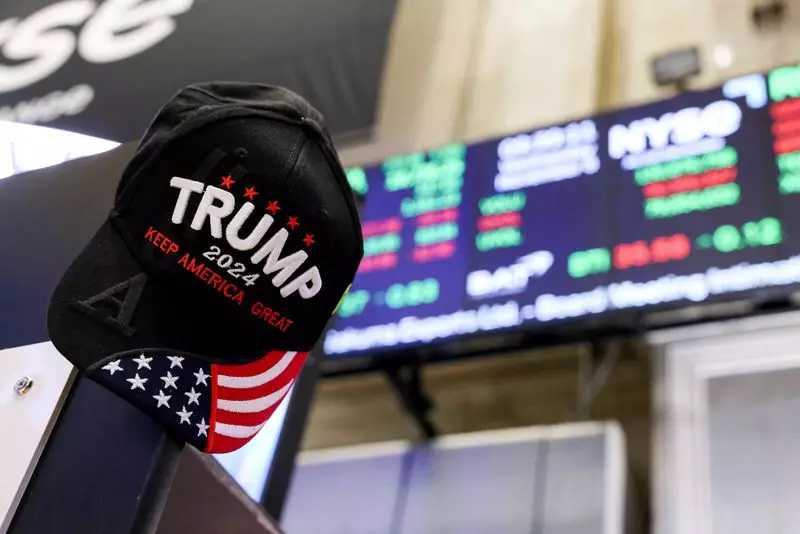On Friday, Wall Street’s major indices experienced a downward trend as investors processed a blend of economic indicators and earnings disclosures, in anticipation of a week brimming with further economic reports and a crucial Federal Reserve meeting. The technology sector emerged as the primary weight on the market, particularly influenced by declines in significant players such as Nvidia, a key figure in the artificial intelligence chips market, which saw its previous gains evaporate amidst a broader market correction.
The latest figures from the housing market exceeded expectations, indicating robust activity. Yet, this optimism encountered a contrasting outlook from an S&P Global survey, which revealed that business activity has decelerated to its lowest point in nine months, coupled with rising prices. In a nod to the ongoing labor market strength, firms reported increased hiring—a development that suggests the Federal Reserve may maintain a cautious but steady approach to monetary policy as the year progresses.
Consumer Confidence Takes a Hit
An important indicator of consumer sentiment—the University of Michigan’s final estimate—plummeted from an earlier assessment of 73.2 down to 71.1. This drop signifies a shift in consumer confidence which can have broad implications for spending and investment behaviors moving forward. As the week came to a close, investors leaned towards the expectation that the Federal Reserve would likely keep interest rates stable during its scheduled meeting on January 28-29. Analysts are also betting on the prospect of the first rate cut occurring in June, a sentiment reflected by data from CME Group’s FedWatch tool.
“Market activity is essentially a reflection of uncertain economic landscapes and mixed earnings outcomes,” remarked Scott Helfstein, head of investment strategy at Global X. This prevailing atmosphere of uncertainty could be further exacerbated by upcoming economic releases and the impending decisions from the new administration on fiscal policies.
Trade Policy and Economic Concerns
One significant concern weighing on investors’ minds is the potential for tariffs proposed by President Donald Trump. The administration’s ambiguous trade policy, which Trump has alluded to repeatedly, has heightened fears of inflation. Experts warn these tariffs, expected to impact countries like Mexico, Canada, and the European Union, could hinder anticipated Federal Reserve rate cuts and further complicate economic stability.
The Dow Jones Industrial Average concluded the week with a drop of 140.82 points, or 0.32%, settling at 44,424.25. The S&P 500 followed, losing 17.47 points (0.29%) to finish at 6,101.24, while the Nasdaq Composite fell by 99.38 points (0.50%), closing at 19,954.30. Despite these losses, the broader indices showed resilience over the preceding week, with the S&P 500 gaining 1.74% overall—a notable rebound considering the band’s fluctuating fortunes.
Amidst Friday’s declines, six out of eleven S&P 500 sectors managed to stay afloat, with sectors like communications services leading the charge with an increase of 1.09%. Utilities also performed well, with NextEra Energy Inc seeing a substantial rise of approximately 5.2%. This uptick positioned it as the S&P 500’s top performer on that day.
In contrast, technology stocks, which had witnessed a resurgence earlier in the week, faced considerable strain with Texas Instruments taking a significant hit following a grim profit forecast for the first quarter. Nvidia also faltered, experiencing a 3.1% drop. Moreover, other tech giants such as Microsoft and Tesla saw declines, contributing to the sector’s sluggish performance on Friday.
On the upside, American Express reported a commendable 12% profit increase for its fourth quarter; nonetheless, its shares dipped by 1.4%. Further dragging on the Dow was Boeing, which warned of a significant anticipated loss, amplifying market apprehensions before its upcoming earnings report.
Despite the overall decline, there were pockets of positivity. Verizon shares saw an uptick of 0.9% thanks to better-than-expected subscription additions. In total, advancing stocks outperformed decliners by a 1.45-to-1 ratio on the NYSE. The end of the week was marked by trading volume in U.S. exchanges, where 14.02 billion shares changed hands—landed slightly shy of the 14.90 billion average seen over the past 20 sessions.
As the markets look towards the upcoming week, investors are gearing up for more significant news, including key inflation data, economic growth indicators, and Federal Reserve policy announcements. The anticipation of these developments sets the stage for what could be a tumultuous period ahead, compounded by ongoing uncertainties surrounding trade policies and economic strategies of the new administration. The landscape remains ripe for further fluctuations, with investors keenly watching for signs that could trigger a shift in sentiment or action from the Fed.

